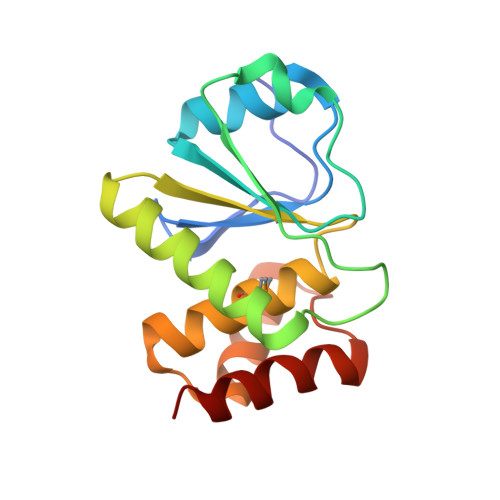Structure of human dual specificity protein phosphatase 23, VHZ, enzyme-substrate/product complex.
Agarwal, R., Burley, S.K., Swaminathan, S.(2008) J Biol Chem 283: 8946-8953
- PubMed: 18245086
- DOI: https://doi.org/10.1074/jbc.M708945200
- Primary Citation of Related Structures:
2IMG - PubMed Abstract:
Protein phosphorylation plays a crucial role in mitogenic signal transduction and regulation of cell growth and differentiation. Dual specificity protein phosphatase 23 (DUSP23) or VHZ mediates dephosphorylation of phospho-tyrosyl (pTyr) and phospho-seryl/threonyl (pSer/pThr) residues in specific proteins. In vitro, it can dephosphorylate p44ERK1 but not p54SAPK-beta and enhance activation of c-Jun N-terminal kinase (JNK) and p38. Human VHZ, the smallest of the catalytically active protein-tyrosine phosphatases (PTP) reported to date (150 residues), is a class I Cys-based PTP and bears the distinctive active site signature motif HCXXGXXRS(T). We present the crystal structure of VHZ determined at 1.93A resolution. The polypeptide chain adopts the typical alphabetaalpha PTP fold, giving rise to a shallow active site cleft that supports dual phosphorylated substrate specificity. Within our crystals, the Thr-135-Tyr-136 from a symmetry-related molecule bind in the active site with a malate ion, where they mimic the phosphorylated TY motif of the MAPK activation loop in an enzyme-substrate/product complex. Analyses of intermolecular interactions between the enzyme and this pseudo substrate/product along with functional analysis of Phe-66, Leu-97, and Phe-99 residues provide insights into the mechanism of substrate binding and catalysis in VHZ.
Organizational Affiliation:
Biology Department, Brookhaven National Laboratory, Upton, NY 11973, USA.
















